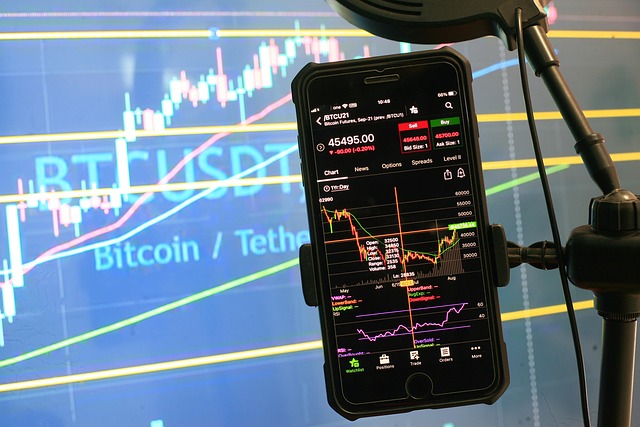Bitcoin Trading History: A Deep Dive into the Evolution of Digital Gold
Author: Jameson Richman Expert
Published On: 2025-08-31
Prepared by Jameson Richman and our team of experts with over a decade of experience in cryptocurrency and digital asset analysis. Learn more about us.
Bitcoin trading history is not merely a chronological sequence of price fluctuations; it embodies a revolutionary paradigm shift in finance, technology, and global economic structures. Over the past decade, Bitcoin has evolved from an obscure digital curiosity to a mainstream financial asset, fundamentally altering how we perceive money, investment, and sovereignty. This comprehensive analysis offers an in-depth exploration of Bitcoin’s trading journey, emphasizing pivotal moments, technological innovations, market dynamics, regulatory developments, and future trajectories. For traders, investors, and enthusiasts, understanding this history provides vital insights into the asset’s transformative potential and ongoing challenges.

The Origins: Birth of Bitcoin and the Genesis of Cryptocurrency Trading
In 2008, amid the chaos of the global financial crisis and widespread distrust of traditional banking systems, the pseudonymous Satoshi Nakamoto published the seminal whitepaper titled “Bitcoin: A Peer-to-Peer Electronic Cash System.” This document proposed a decentralized digital currency that eliminates the need for trusted third parties, leveraging blockchain technology—a transparent, immutable, and distributed ledger that records all transactions securely. Following this, Bitcoin was launched in January 2009 with the mining of the genesis block, marking the start of a new financial era rooted in cryptography, decentralization, and peer-to-peer networks.
Early Bitcoin development was characterized by a community of cryptography enthusiasts, programmers, and libertarians experimenting with the technology. The initial value was negligible, with early trades happening informally among a niche group, often via online forums, mailing lists, or direct wallet exchanges. The protocol’s fixed supply—capped at 21 million coins—laid the foundation for its narrative as a deflationary store of value. The first notable real-world transaction occurred in May 2010 when Laszlo Hanyecz paid 10,000 BTC for two pizzas—an event now famously commemorated as “Bitcoin Pizza Day”—providing the first practical valuation and demonstrating its potential as a medium of exchange. During these nascent days, trading was highly experimental, with no official exchanges, leading to high bid-ask spreads, low liquidity, and significant risk, but also setting the stage for innovation.
The Dawn of Formalized Bitcoin Trading: Emergence of Exchanges
Between 2010 and 2011, the landscape shifted from informal barter to structured markets with the emergence of dedicated exchanges. The launch of BitcoinMarket in March 2010, the first Bitcoin exchange platform, was a watershed moment. It facilitated trading of BTC against fiat currency (USD), enabling price discovery and providing liquidity—crucial for broader adoption. Although limited in trading volume initially, BitcoinMarket demonstrated the viability of centralized platforms and paved the way for future development.
The year 2011 marked a turning point with the rise of Mt. Gox, a Tokyo-based exchange founded in 2010. At its peak, Mt. Gox handled approximately 70% of global Bitcoin trading volume, reflecting both the surging demand and the speculative nature of early traders. The platform’s user-friendly interface, combined with its reputation for liquidity and ease of converting Bitcoin to fiat currencies, made it the dominant exchange worldwide. However, its infamous collapse in 2014—after losing around 850,000 BTC due to hacking, mismanagement, and fraud—exposed systemic vulnerabilities in the early cryptocurrency infrastructure. This event prompted widespread industry reforms, including stricter security protocols, transparency initiatives, and regulatory compliance measures, which collectively aimed to restore confidence and prepare the ecosystem for institutional participation.
Price Volatility and Market Maturation (2012-2017)
From 2012 through 2017, Bitcoin’s trading history was characterized by exponential growth, punctuated by extreme volatility and speculative bubbles. The year 2013 was particularly transformative: Bitcoin’s price surged from roughly $13 in January to over $1,100 in December. This meteoric rise was driven by increasing merchant acceptance, media hype, and speculative trading, attracting new participants worldwide. During this period, derivatives markets also emerged—futures, options, and other financial instruments—allowing traders to hedge, leverage, and speculate, which added complexity and systemic risk to the ecosystem.
However, this rapid expansion was accompanied by significant crashes. The collapse of Mt. Gox, security breaches, and regulatory crackdowns led to prolonged bear markets, with Bitcoin dipping below $200 in 2015. Despite these setbacks, the downturns spurred industry maturation: exchanges adopted better security standards, regulatory oversight increased, and institutional interest grew. The development of Bitcoin-based financial products such as trust funds and ETFs (Exchange-Traded Funds)—notably the Winklevoss Bitcoin Trust—signified growing legitimacy. During this phase, Bitcoin started being recognized not just as a speculative asset but also as a potential store of value—often called “digital gold”—setting the stage for its role as a hedge against macroeconomic instability.

Regulatory Evolution and Institutional Acceptance
From 2015 onward, regulatory frameworks began to take shape worldwide, influencing Bitcoin’s trading environment significantly. Countries like Japan and Switzerland pioneered by establishing clear licensing regimes, consumer protections, and anti-money laundering (AML) standards, fostering innovation and market stability. Conversely, nations such as China imposed bans and restrictions, emphasizing the geopolitical divide in approaches to digital assets. These regulations aimed to strike a balance—encouraging innovation while curbing illicit activities like money laundering and fraud.
The late 2017 launch of Bitcoin futures contracts on CME and CBOE was a watershed moment. These regulated derivatives provided institutional investors with tools for hedging and speculation, greatly increasing market depth, liquidity, and investor confidence. The futures market introduced new dynamics, including backwardation and contango, that influenced spot prices and trading strategies. The development of custody solutions, compliance standards, and professional trading platforms further legitimized Bitcoin trading, attracting institutional players and mainstream financial firms.
Global Adoption and Market Expansion (2018-2023)
Between 2018 and 2023, Bitcoin’s trading ecosystem experienced unprecedented expansion. Major corporations like MicroStrategy, Tesla, and Galaxy Digital made large Bitcoin acquisitions, boosting market confidence and liquidity. Retail traders worldwide gained access through user-friendly exchanges offering fiat on-ramps—such as Binance, Coinbase, and Kraken—further broadening participation.
Technological progress notably impacted trading dynamics. The Lightning Network, a second-layer protocol, enhanced transaction speeds and reduced fees, making Bitcoin viable for microtransactions and everyday use. Simultaneously, DeFi platforms began integrating Bitcoin as collateral for decentralized lending, liquidity pools, and yield farming—creating new financial instruments and trading strategies that transcended simple speculation.
Furthermore, the proliferation of Bitcoin ETFs, custodial solutions, and institutional-grade trading platforms—such as Fidelity Digital Assets—lowered barriers for traditional investors, embedding Bitcoin within conventional financial portfolios. Countries like El Salvador adopting Bitcoin as legal tender and ongoing exploration of Central Bank Digital Currencies (CBDCs) by governments worldwide underscored Bitcoin’s influence on the future of money and financial sovereignty.
Market Trends, Challenges, and the Future Outlook
As Bitcoin matures into a more sophisticated asset class, its trading environment is shaped by macroeconomic shifts, regulatory changes, and continuous technological innovation. Institutional participation—via ETFs, direct spot trading, and integration into ESG portfolios—is on the rise. Advancements in social trading platforms, algorithmic trading, and AI-driven market analysis have increased accessibility and efficiency, attracting a broader demographic of traders and investors.
However, significant challenges remain. High volatility persists, driven by macroeconomic uncertainties, geopolitical tensions, regulatory flux, and macro-events such as economic downturns or security breaches. External shocks can cause rapid and severe price swings. Additionally, technological vulnerabilities—like scalability issues, the potential threat of quantum computing, network congestion, and evolving security risks—demand ongoing innovation and resilience.
Looking forward, Bitcoin’s potential roles include serving as a hedge against inflation, a digital gold, or a reserve currency. The expansion of CBDCs, increasing adoption in emerging economies, and clearer international regulatory standards could accelerate mainstream acceptance. Nevertheless, responsible trading, thorough risk management, and continuous education remain vital in navigating this evolving landscape. The development of regulatory clarity and technological upgrades will be instrumental in shaping its future trajectory.

Joining the Bitcoin Trading Ecosystem Today
For aspiring traders and investors keen to participate, selecting a secure, transparent, and regulated trading platform is crucial. Leading exchanges such as MEXC, Bitget, and Bybit provide robust platforms with deep liquidity, a variety of trading instruments—including spot, futures, options, and perpetual swaps—and comprehensive educational resources. Many also offer demo accounts and advanced risk management tools, vital for beginners and seasoned traders alike.
Successful participation demands thorough research, disciplined trading strategies, and employing risk mitigation techniques such as stop-loss orders and portfolio diversification. Staying informed about market cycles, macroeconomic indicators, technological updates, and regulatory developments will enhance decision-making and resilience amidst volatility.
Conclusion: From Humble Beginnings to a Financial Revolution
The history of Bitcoin trading exemplifies technological innovation, resilience, and a transformative force in global finance. From its origin as an experimental digital cash system to a multibillion-dollar asset class challenging traditional monetary systems, Bitcoin has redefined the concepts of money, value storage, and sovereignty. Its evolution underscores the critical importance of ongoing technological progress, adaptive regulation, and market maturity.
As Bitcoin continues to develop, understanding its historical context provides essential insights for engaging responsibly and strategically in its future. Whether as an investor, trader, or enthusiast, staying informed, vigilant, and adaptable will be key. The journey from a niche experiment to a cornerstone of global finance exemplifies resilience and innovation—traits that will likely define Bitcoin’s ongoing trajectory amid technological, regulatory, and economic shifts. The next chapters promise further growth, but also demand responsible participation, continuous education, and strategic foresight in this highly dynamic landscape.